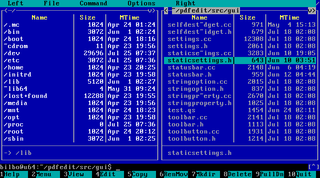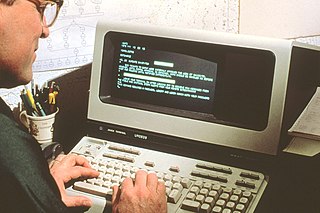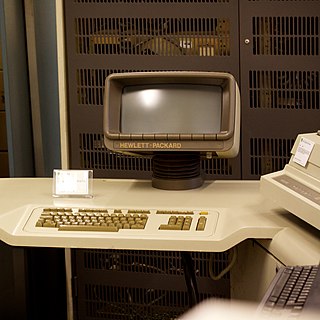C is a general-purpose computer programming language. It was created in the 1970s by Dennis Ritchie, and remains very widely used and influential. By design, C's features cleanly reflect the capabilities of the targeted CPUs. It has found lasting use in operating systems, device drivers, and protocol stacks, but its use in application software has been decreasing. C is commonly used on computer architectures that range from the largest supercomputers to the smallest microcontrollers and embedded systems.
In computing and telecommunication, an escape character is a character that invokes an alternative interpretation on the following characters in a character sequence. An escape character is a particular case of metacharacters. Generally, the judgement of whether something is an escape character or not depends on the context.
HP-GL, short for Hewlett-Packard Graphics Language and often written as HPGL, is a printer control language created by Hewlett-Packard (HP). HP-GL was the primary printer control language used by HP plotters. It was introduced with the plotter HP-9872 in 1977 and became a standard for almost all plotters. Hewlett-Packard's printers also usually support HP-GL/2 in addition to PCL.
In computer science, an escape sequence is a combination of characters that has a meaning other than the literal characters contained therein; it is marked by one or more preceding characters.
The backslash\ is a mark used mainly in computing and mathematics. It is the mirror image of the common slash /. It is a relatively recent mark, first documented in the 1930s. It is sometimes called a hack, whack, escape, reverse slash, slosh, downwhack, backslant, backwhack, bash, reverse slant, reverse solidus, and reversed virgule.
The C preprocessor is the macro preprocessor for several computer programming languages, such as C, Objective-C, C++, and a variety of Fortran languages. The preprocessor provides inclusion of header files, macro expansions, conditional compilation, and line control.

Box-drawing characters, also known as line-drawing characters, are a form of semigraphics widely used in text user interfaces to draw various geometric frames and boxes. These characters are characterized by being designed to be connected horizontally and/or vertically with adjacent characters, which requires proper alignment. Box-drawing characters therefore typically only work well with monospaced fonts.

The HP 300 "Amigo" was a computer produced by Hewlett-Packard (HP) in the late 1970s based loosely on the stack-based HP 3000, but with virtual memory for both code and data. The HP300 was cut-short from being a commercial success despite the huge engineering effort, which included HP-developed and -manufactured silicon on sapphire (SOS) processor and I/O chips.

The HP 2640A and other HP 264X models were block-mode "smart" and intelligent ASCII standard serial terminals produced by Hewlett-Packard using the Intel 8008 and 8080 microprocessors.
HP Time-Shared BASIC is a BASIC programming language interpreter for Hewlett-Packard's HP 2000 line of minicomputer-based time-sharing computer systems. TSB is historically notable as the platform that released the first public versions of the game Star Trek.

The HP 250 was a multiuser business computer by Hewlett-Packard running HP 250 BASIC language as its OS with access to HP's IMAGE database management. It was produced by the General Systems Division (GSD), but was a major repackaging of desktop workstation HP 9835 from the HP 9800 series which had been sold in small business configurations. The HP 9835's processor was initially used in the first HP 250s.
The National Replacement Character Set (NRCS) was a feature supported by later models of Digital's (DEC) computer terminal systems, starting with the VT200 series in 1983. NRCS allowed individual characters from one character set to be replaced by one from another set, allowing the construction of different character sets on the fly. It was used to customize the character set to different local languages, without having to change the terminal's ROM for different countries, or alternately, include many different sets in a larger ROM. Many 3rd party terminals and terminal emulators supporting VT200 codes also supported NRCS.

Extended ASCII is a repertoire of character encodings that include the original 96 ASCII character set, plus up to 128 additional characters. There is no formal definition of "extended ASCII", and even use of the term is sometimes criticized, because it can be mistakenly interpreted to mean that the American National Standards Institute (ANSI) had updated its ANSI X3.4-1986 standard to include more characters, or that the term identifies a single unambiguous encoding, neither of which is the case.
In computing HP Roman is a family of character sets consisting of HP Roman Extension, HP Roman-8, HP Roman-9 and several variants. Originally introduced by Hewlett-Packard around 1978, revisions and adaptations were published several times up to 1999. The 1985 revisions were later standardized as IBM codepages 1050 and 1051. Supporting many European languages, the character sets were used by various HP workstations, terminals, calculators as well as many printers, also from third-parties.
In the C programming language, an escape sequence is specially delimited text in a character or string literal that represents one or more other characters to the compiler. It allows a programmer to specify characters that are otherwise difficult or impossible to specify in a literal.
C++17 is a version of the ISO/IEC 14882 standard for the C++ programming language. C++17 replaced the prior version of the C++ standard, called C++14, and was later replaced by C++20.
The RPL character set is an 8-bit character set and encoding used by most RPL calculators manufactured by Hewlett-Packard as well as by the HP 82240B thermo printer. It is sometimes referred to simply as "ECMA-94" in documentation, although it is for the most part a superset of ISO/IEC 8859-1 / ECMA-94 in terms of printable characters, and it differs from ISO/IEC 8859-1 by using displayable characters rather than control characters in the 0x80 to 0x9F range of code points.
The Lotus International Character Set (LICS) is a proprietary single-byte character encoding introduced in 1985 by Lotus Development Corporation. It is based on the 1983 DEC Multinational Character Set (MCS) for VT220 terminals. As such, LICS is also similar to two other descendants of MCS, the ECMA-94 character set of 1985 and the ISO 8859-1 (Latin-1) character set of 1987.
In computing FOCAL character set refers to a group of 8-bit single byte character sets introduced by Hewlett-Packard since 1979. It was used in several RPN calculators supporting the FOCAL programming language, like the HP-41C/CV/CX as well as the later HP-42S, which was introduced in 1988 and produced up to 1995. As such, it is also used by SwissMicros' DM41/L, both introduced in 2015, and is implicitly supported by the DM42, introduced in 2017.
Caret is the name used familiarly for the character ^ provided on most QWERTY keyboards by typing ⇧ Shift+6. The symbol has a variety of uses in programming and mathematics. The name "caret" arose from its visual similarity to the original proofreader's caret, a mark used in proofreading to indicate where a punctuation mark, word, or phrase should be inserted into a document. The formal ASCII standard (X3.64.1977) calls it a "circumflex".




